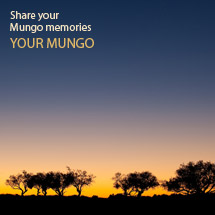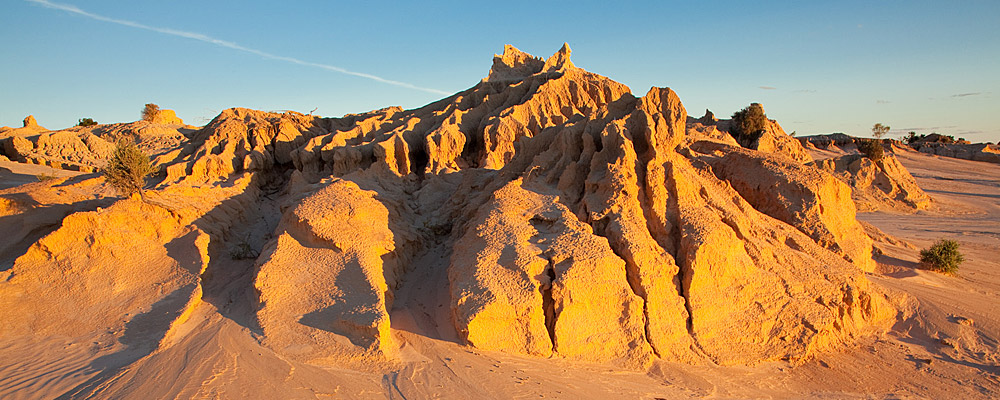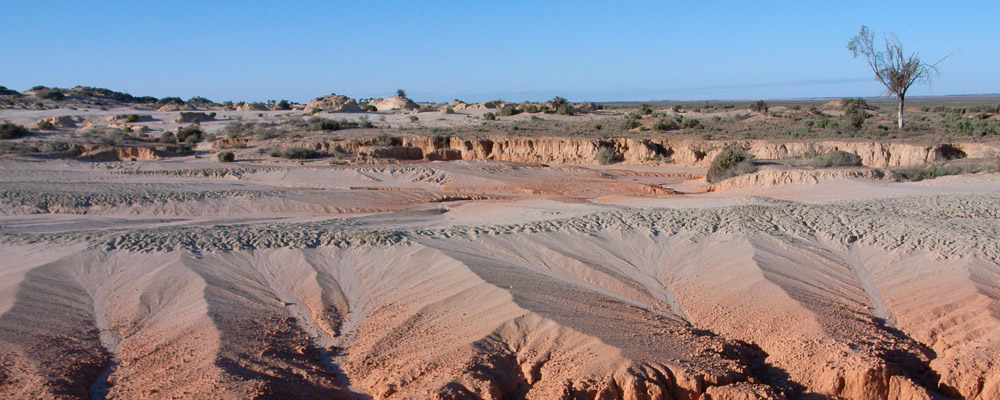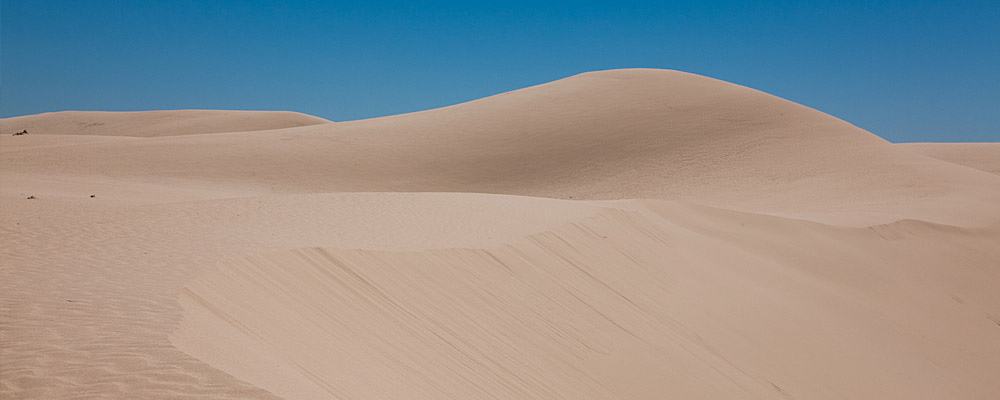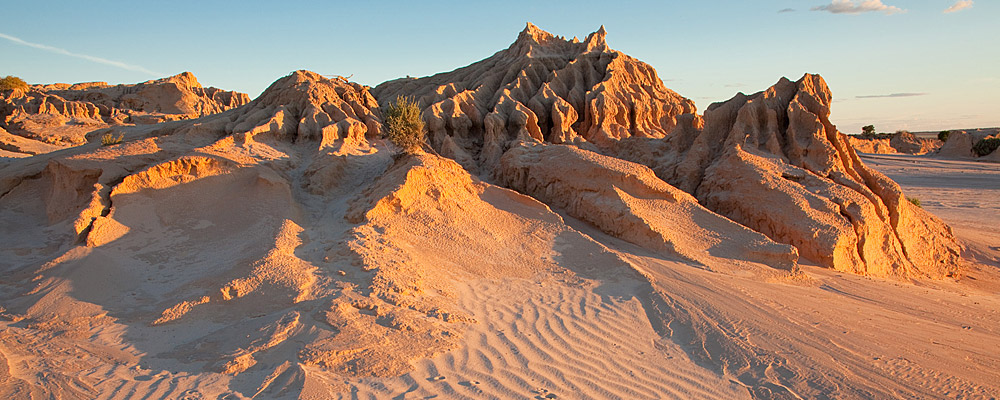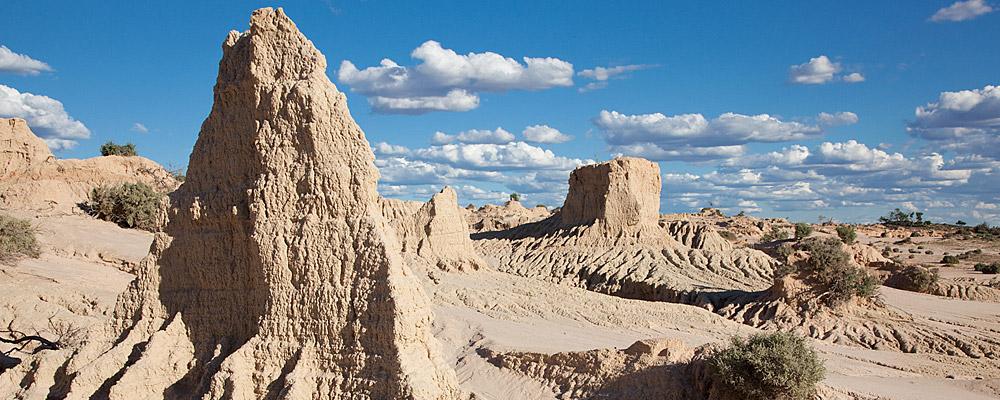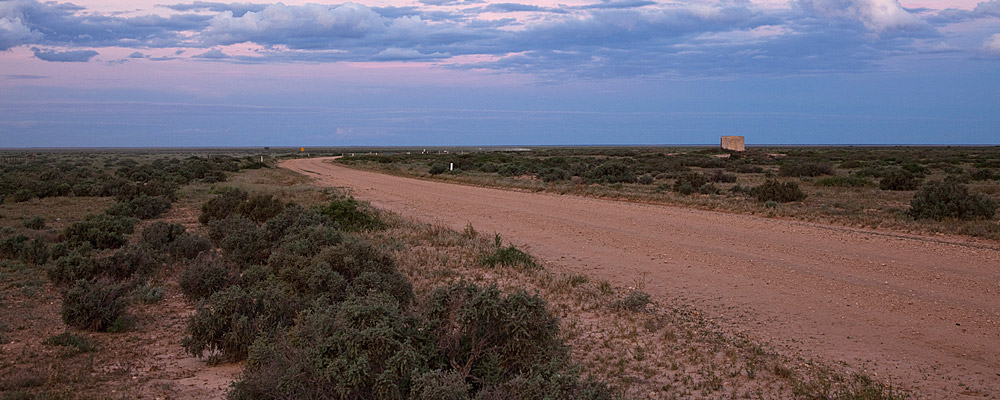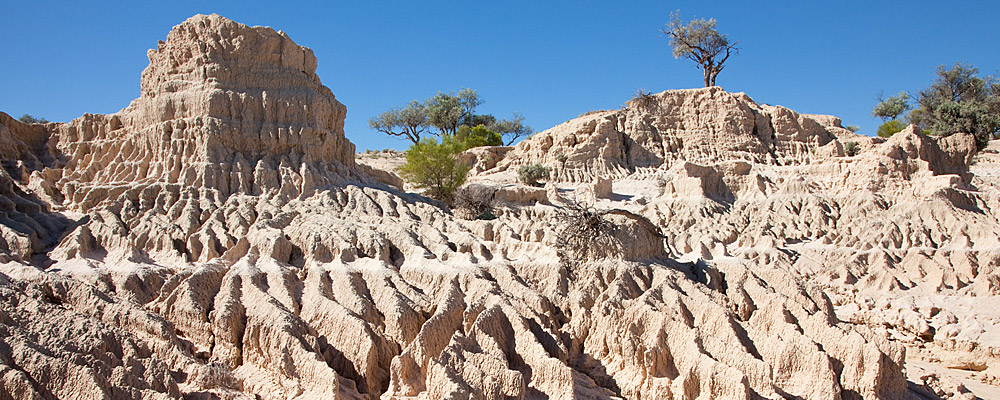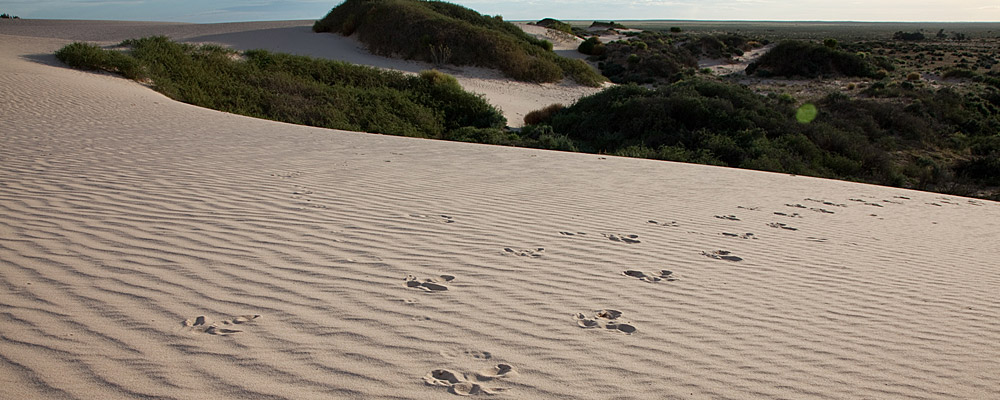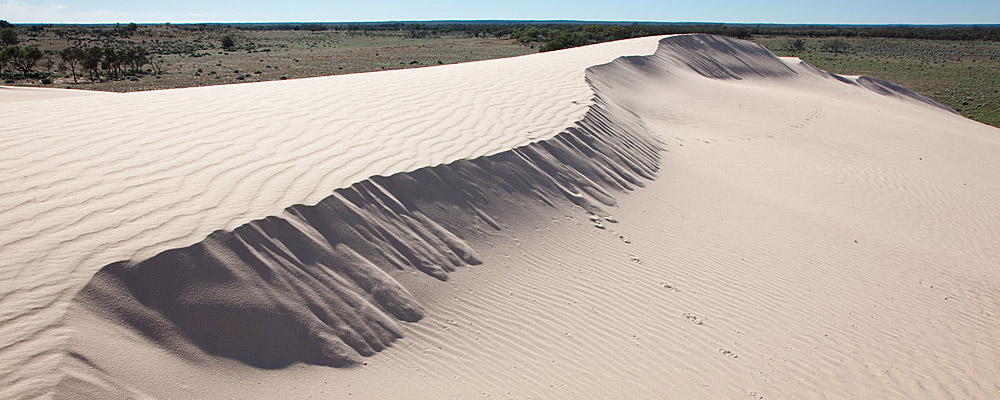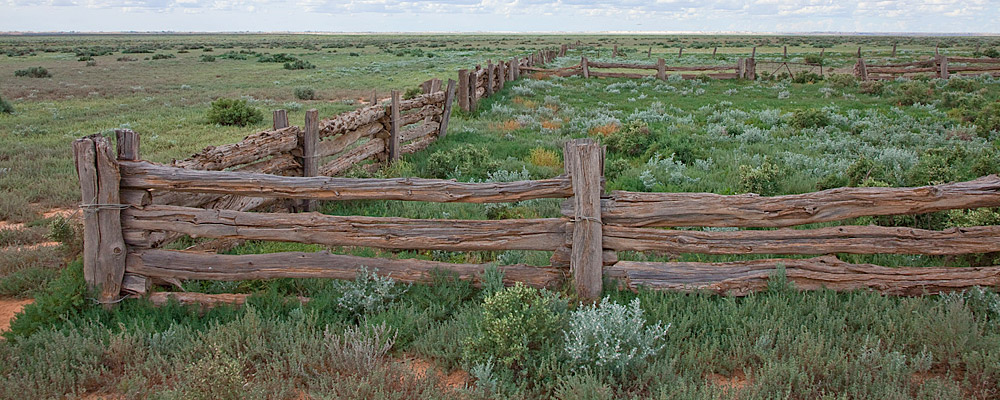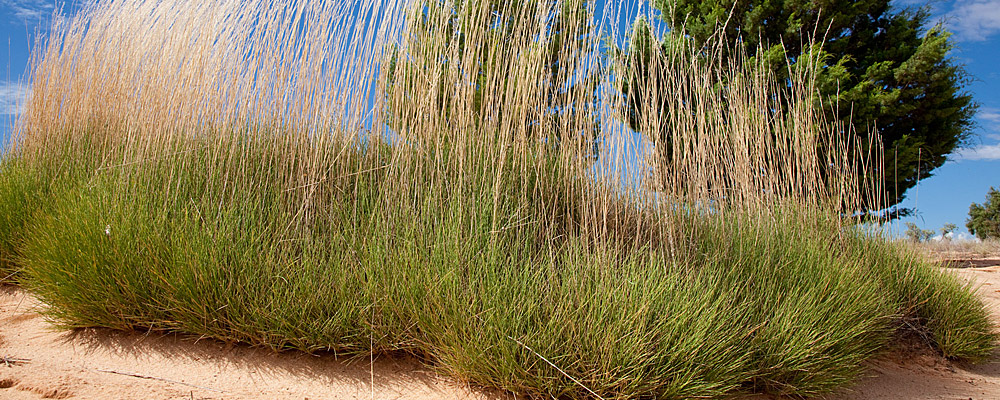Understanding Mungo
Animals
Wildlife
Any trip to Mungo would be incomplete without seeing a mob of Emus prancing through the bluebush, cockatoos screeching at sunset or a Red Kangaroo scratching himself in the morning light. Back when the lakes were full the place was brimming with wildlife that nourished the Aboriginal inhabitants - ducks, swans, waders, pigeons, fish, yabbies, lizards, bettongs, bandicoots, wallabies, mice, rats and more. The fish and waterbirds are long gone, and many of the small mammals disappeared more recently, but the native fauna remains a fascinating part of Mungo's outback mystique.
A great variety of native vertebrate animals has been recorded here - 110 species of birds, 22 mammal species and 62 reptile species. Eighteen of these are classified as endangered.
Mammals
The first ground-dwelling animals you'll see in Mungo National Park will probably be our largest marsupials - kangaroos. These herbivores spend their days grazing quietly in the grasslands or resting in a scratched-out pad in the woodland shade. The best time to observe kangaroos is from about 4 pm through to 9 am. You'll need to be very quiet because they are shy and easily scared.
At Mungo there are three species of large kangaroo:
- Red Kangaroo (Macropus rufus).
- The males are the easiest to identify by their earthy red coats and pale belly, legs and tail. Some males can be the colour of bluebush, while the females are generally blue-grey and smaller.
- Western Grey Kangaroo (Macropus fuliginosus).
- This 'roo is sooty grey tinged with a rust colour, and is adapted to scrub and woodland communities. Western greys are commonly known as 'scrubbers', possibly due to their appearance, or their habitat.
- Eastern Grey Kangaroo (Macropus giganteus).
- This is very similar in appearance to a western grey, but doesn't have the western grey's tell-tale black fur on its extremities.
Of the three species, the Red Kangaroo is better adapted to drought conditions because it doesn't stick to a home range but roams to follow good conditions.
Following ancient tradition, the Paakantji and Ngiyampaa people do not eat grey kangaroos.
You might be lucky enough to see a Short-beaked Echidna (Tachyglossus aculeatus) while you're in Mungo. These monotremes are highly specialised feeders, devouring ants, termites, grub larvae, worms, mites, insect pupae and small spiders. They seek out food by ripping open logs and stumps or digging into ant mounds and nests, guided by smell and minute electrical signals detected in the snout.
In summer you'll probably see echidnas more at dawn and dusk, but in the cooler months they can be found throughout the day, taking advantage of the temperate conditions. Look closely at an echidna and you'll see a layer of fur between the spines, the colour of which varies with the environments they live in.
The echidna usually seeks shelter in rabbit or wombat burrows, hollow logs or thick bushes, while females build their own burrows when incubating or suckling their young. Although echidnas are known to hibernate in the cold regions of the east and south, it's unlikely that they do this as far west as Mungo National Park.
A number of small and medium-sized mammals have become extinct in the Willandra area since white settlement (see Recent Changes), but others still survive. These include two mouse-sized, carnivorous marsupials: the Fat-tailed Dunnart (Sminthopsis crassicaudata), which stores fat in its tail for lean times and whose nocturnal tracks can often be seen on the dunes and the Common Dunnart (S. murina). The Southern Ningaui (Ningaui yvonneae) is a tiny but energetic predator that weighs only about 10 grams. It lives in the mallee country and eats insects, spiders and small lizards. This ningaui is endangered by loss of habitat, predation by foxes and cats, grazing and frequent fires.
In the evenings, you might see small insect-eating bats (microbats) flitting around the sky. Bats are the most diverse group of mammals in Willandra, with nine species including the endangered Little Pied Bat (Chalinolobus picatus). These microbats roost in hollow trees, and sometimes in old farm buildings.
Birds
Mungo supports a wide variety of bird life, mainly due to the varied landforms and habitat of the region. About 150 species can be seen here, but some are more conspicuous than others.
While bushwalking through the mallee community for example, there's a good chance you'll spot some Mallee Ringnecks (Barnardius zonarius). These parrots hang out in flocks or pairs, and can be identified by their green plumage and creamy-yellow neck band. They're about 30 cm long and, like most parrots, are brightly coloured and wonderful to watch. They usually nest in tree hollows and feed on grass seeds, herbs, berries, fruit, buds and blossoms, as well as the seeds of red gum and Yorrell.
A very sociable animal, especially around campgrounds, is the grey Apostlebird (Struthidea cinerea), so named because they hang around in family groups, sometimes of about a dozen birds. They are also referred to locally as 'bludger birds', because they're always on the lookout for food scraps. But please don't feed them because anything but their natural food of seeds and insects is not good for their health.
Apart from the largest Australian bird of all, the flightless Emu (Dromaius novaehollandiae), other bird species you might see in various parts of the park include:
- Galah
- Eolophus roseicapillus
- Pink Cockatoo
- Lophochroa leadbeateri
- Red-rumped Parrot
- Psephotus haematonotus
- Blue Bonnets
- Northiella haematogaster
- Budgerigars
- Melopsittacus undulatus
- Zebra Finches
- Taeniopygia guttata
- Common Bronzewing
- Phaps chalcoptera
- Crested Pigeon
- Ocyphaps lophotes
- Singing Honeyeater
- Lichenostomus virescens
- Australasian Pipit
- Anthus novaeseelandiae
- Variegated Fairy-wren
- Malurus lamberti
Many of these birds can be seen drinking at one time or another from the ground tanks located around the park. Generally each species has a specific drinking time, and once you've worked these out, you can be ready to watch each species at its favourite time. At times there may only be a handful of birds drinking, while at others the watering spot will be bustling with excitement and intense chatter as the birds come in for a drink during a dry spell. These are perfect opportunities for observing the interactions and specific characters of some of these outback birds.
If you're visiting the lakebed, which is covered with various species of saltbush and bluebush, keep an eye out for the Orange Chat (Epthianura aurifrons). This little bird will most likely be running across the ground. The male will be an orange-red colour and the female more of an orange-yellow.
Much more brilliant however, is the Crimson Chat (Epthianura tricolor), which can be found within the bushes along the edges of mallee habitat. Again you'll notice that the males have more dominant colours. The female has mottled tinges of red on her forehead, and the same on her cream belly, while the male displays a vivid red bonnet and apron.
Chats are highly colourful little creatures and are among the few small birds that walk, but do not hop. They have a brush-like tip on their tongue, assumed to be an adaptation for extracting nectar from the flowering plants of the region. Their nests, cup-shaped and made of fine twigs and grasses, can be found on low bushes in spinifex clumps, or on the ground.
Keep an eye out for the Pink Cockatoos, which can at times be seen in their hundreds, particularly when coming in to roost for the night.
If you are stopped in wonder by the sounds of a rich and melodious call, it's most likely the flute-like song of one of the species of butcher birds.
Another wonder to keep an eye out for is the Nankeen Kestrel (Falco cenchroides), sometimes referred to as a sparrow hawk. This tan-coloured bird with darker, pointed wing-tips is amazing to watch as it hovers in place watching for signs of movement on the ground, perhaps a mouse, an invertebrate, or something from the reptile kingdom.
Once sighted, the little kestrel tucks in its wings and dives straight for its target. With prey clutched tightly in its talons, it alights on a stump, branch, or fence post to savour the rewards of its efforts.
Threatened bird species recorded for the Mungo area include:
- Australian Bustard
- Ardeotis australis
- Chestnut Quail Thrush
- Cinclosoma castanotum
- Gilbert's Whistler
- Pachycephala inornata
- Pink Cockatoo
- Lophochroa leadbeateri
- Malleefowl
- Leipoa ocellata
Reptiles
A walk through any habitat in the park will undoubtedly result in the sighting of one of the many lizards and snakes to be found at Mungo. Forty species of reptiles have been recorded here, including ten species of gecko and sixteen species of skinks.
The largest reptile in the park is the harmless Carpet Python (Morelia spilota), which can grow up to four metres long, but is more likely to be two metres. These animals are models of patience, as they will hang from a branch over a known animal track for up to a week. The snake will wait for something to pass by, and if nothing does, it will simply pack up camp and try somewhere else.
The Carpet Python is a beautiful snake, with superb pale to dark brown colouring with black splotches and yellow patterned markings over the full length of the body. The under surface is cream or yellow blotched with dark grey.
You probably won't come across a snake in or around the park's campsites, but they are not uncommon outside the camping area. Snakes are naturally shy animals and will avoid contact with humans wherever possible. It's best not to take chances though, and to be aware that they're around and that it's their home you are visiting. Wear sensible footwear, and if you do happen to come across a snake, just walk calmly away.
Three of the snake species in the park are listed as dangerous:
- Western Brown Snake (1.5 m)
- Pseudonaja nuchalis
- Eastern Brown Snake (1.5 m)
- Pseudonaja textilis
- Mulga, or King Brown Snake (2 m)
- Pseudechis australis
Several reptile species make their home in the saltbush, including the Shingleback (Tiliqua rugosa), sometimes known as the stumpy-tail or sleepy lizard. You may find a Shingleback resting under a shrub or sunning itself in the open. Their diet consists of vegetable matter such as fruit and berries or ground blossoms, but they will also eat insects and snails.
The Lined Earless Dragon (Tympanocryptis lineata lineata) lives in many of the different habitats of Mungo. Don't let the name fool you, for this lizard grows to only 15 cm long. It's quite attractive in its brown, black and orange outfit, with thin white stripes running the length of its body. It lacks visible ear openings - hence the name.
While you're driving around or hiking, keep an eye on fence posts, stumps, and shrubs, where you are likely to see a Bearded Dragon (Pogona barbata). These lizards like sunning themselves in unusual, but very practical places. Being reptiles and cold blooded, they use the energy of the sun to regulate their body temperature. They grow up to 40-55 cm long.
Other species you might see include:
- Mallee Dragon
- Amphibolurus fordi
- Gould's Goanna
- Varanus gouldii
- Western Blue Tongue Lizard
- Tiliqua occipitalis (threatened species)
- Spinifex Slender Blue-tongue lizard
- Cyclodomorphus melanops (threatened species)
Frogs
Not much is known about the amphibians in the park. The Common Spade Foot Toad (Neobatrachus sudelli), Long Thumbed Frog (Limnodynastes fletcheri) and the Spotted Grass Frog (L. tasmaniensis) are reasonably common around ground tanks, particularly those that hold water for long periods. The threatened Painted Burrowing Frog (Neobatrachus pictus) may also potentially live here.
Invertebrates
Many of the mammals and birds in Mungo rely on invertebrates such as beetles, bugs, spiders and insect larvae for food. Some invertebrates rely on the vegetation of the park for food and protection from the surrounding environment. They return the favour by helping to pollinate plants, forming an essential link for plant reproduction.
Fauna List
This is a full list of all mammals, birds, reptiles and amphibians recorded for Mungo National Park as at June 2010 (Source: NSW Wildlife Atlas). Species are listed in alphabetical order on scientific name (genus).
# species listed under Threatened Species Act
* introduced species
Mammals
- Scientific name
- Common Name
- Cercartetus concinnus#
- Western Pygmy Possum
- Chalinolobus gouldii
- Gould's Wattled Bat
- Chalinolobus picatus#
- Little Pied Bat
- Felis catus*
- Cat
- Macropus fuliginosus
- Western Grey Kangaroo
- Macropus giganteus
- Eastern Grey Kangaroo
- Macropus rufus
- Red Kangaroo
- Mormopterus planiceps
- Little Mastiff-bat
- Mus musculus*
- House Mouse
- Ningaui yvonneae#
- Southern Ningaui
- Nyctophilus geoffroyi
- Lesser Long-eared Bat
- Nyctophilus timoriensis#
- Greater Long-eared Bat (south-eastern form)
- Oryctolagus cuniculus*
- Rabbit
- Planigale tenuirostris
- Narrow-nosed Planigale
- Rattus villosissimus#
- Long-haired Rat
- Scotorepens balstoni
- Inland Broad-nosed Bat
- Sminthopsis crassicaudata
- Fat-tailed Dunnart
- Sminthopsis murina
- Common Dunnart
- Tachyglossus aculeatus
- Short-beaked Echidna
- Tadarida australis
- White-striped Freetail-bat
- Vulpes vulpes*
- Fox
- Vespadelus baverstocki#
- Inland Forest Bat
Reptiles
- Scientific name
- Common Name
- Acanthiza apicalis
- Inland Thornbill
- Acanthiza chrysorrhoa
- Yellow-rumped Thornbill
- Acanthiza nana
- Yellow Thornbill
- Acanthiza uropygialis
- Chestnut-rumped Thornbill
- Accipiter cirrocephalus
- Collared Sparrowhawk
- Accipiter fasciatus
- Brown Goshawk
- Aegotheles cristatus
- Australian Owlet-nightjar
- Amphibolurus nobbi
- Nobbi
- Amphibolurus nobbi coggeri
- Aphelocephala leucopsis
- Southern Whiteface
- Aquila audax
- Wedge-tailed Eagle
- Brachyurophis australis
- Coral Snake
- Cryptoblepharus australis
- Inland Snake-eyed Skink
- Ctenophorus fordi
- Mallee Military Dragon
- Ctenophorus pictus
- Painted Dragon
- Ctenotus atlas
- Southern Mallee Ctenotus
- Ctenotus brachyonyx
- Short-clawed Ctenotus
- Ctenotus olympicus
- Ctenotus regius
- Pale-rumped Ctenotus
- Ctenotus schomburgkii
- Barred Wedgesnout Ctenotus
- Ctenotus strauchii
- Eastern Barred Wedgesnout Ctenotus
- Cyclodomorphus melanops elongatus#
- Mallee Slender Blue-tongue Lizard
- Delma butleri
- Unbanded Delma
- Demansia psammophis
- Yellow-faced Whip Snake
- Diplodactylus elderi#
- Jewelled Gecko
- Diplodactylus tessellatus
- Tessellated Gecko
- Diplodactylus vittatus
- Wood Gecko
- Egernia striolata
- Tree Skink
- Elanus axillaris
- Black-shouldered Kite
- Eremiascincus fasciolatus
- Narrow-banded Sand-swimmer
- Eremiascincus richardsonii
- Broad-banded Sand-swimmer
- Gehyra variegata
- Tree Dtella
- Haliaeetus leucogaster
- White-bellied Sea-Eagle
- Heteronotia binoei
- Bynoe's Gecko
- Hieraaetus morphnoides#
- Little Eagle
- Lerista muelleri
- Wood Mulch-slider
- Lerista punctatovittata
- Eastern Robust Slider
- Lialis burtonis
- Burton's Snake-lizard
- Liopholis inornata
- Desert Skink
- Lucasium damaeum
- Beaded Gecko
- Menetia greyii
- Common Dwarf Skink
- Milvus migrans
- Black Kite
- Morethia adelaidensis
- Saltbush Morethia Skink
- Morethia boulengeri
- South-eastern Morethia Skink
- Nephrurus levis
- Three-lined Knob-tail
- Parasuta nigriceps
- Mitchell's Short-tailed Snake
- Pogona vitticeps
- Central Bearded Dragon
- Pseudechis australis
- King Brown Snake
- Pseudonaja nuchalis
- Western Brown Snake
- Pygopus schraderi
- Eastern Hooded Scaly-foot
- Ramphotyphlops bicolor
- Ramphotyphlops bituberculatus
- Prong-snouted Blind Snake
- Ramphotyphlops sp.
- blind snake
- Rhynchoedura ornata
- Beaked Gecko
- Smicrornis brevirostris
- Weebill
- Strophurus intermedius
- Southern Spiny-tailed Gecko
- Suta suta
- Curl Snake
- Tiliqua rugosa
- Shingle-back
- Tympanocryptis lineata
- Lined Earless Dragon
- Underwoodisaurus milii
- Thick-tailed Gecko
- Varanus gouldii
- Gould's Goanna
Birds
- Scientific name
- Common Name
- Acanthagenys rufogularis
- Spiny-cheeked Honeyeater
- Anas gracilis
- Grey Teal
- Anas superciliosa
- Pacific Black Duck
- Anthochaera carunculata
- Red Wattlebird
- Anthus novaeseelandiae
- Australian Pipit
- Ardea pacifica
- White-necked Heron
- Ardeotis australis#
- Australian Bustard
- Artamus cinereus
- Black-faced Woodswallow
- Artamus leucorynchus
- White-breasted Woodswallow
- Artamus personatus
- Masked Woodswallow
- Artamus superciliosus
- White-browed Woodswallow
- Barnardius zonarius barnardi
- Mallee Ringneck
- Cacatua leadbeateri#
- Pink Cockatoo
- Cacatua sanguinea
- Little Corella
- Cacomantis pallidus
- Pallid Cuckoo
- Chalcites basalis
- Horsfield's Bronze-Cuckoo
- Charadrius australis
- Inland Dotterel
- Chenonetta jubata
- Australian Wood Duck
- Cheramoeca leucosterna
- White-backed Swallow
- Chroicocephalus novaehollandiae
- Silver Gull
- Cincloramphus cruralis
- Brown Songlark
- Cincloramphus cruralis
- Brown Songlark
- Cincloramphus mathewsi
- Rufous Songlark
- Cinclosoma castanotus#
- Chestnut Quail-thrush
- Climacteris affinis
- White-browed Treecreeper
- Climacteris picumnus#
- Brown Treecreeper
- Colluricincla harmonica
- Grey Shrike-thrush
- Columba livia*
- Rock Dove
- Coracina novaehollandiae
- Black-faced Cuckoo-shrike
- Corcorax melanorhamphos
- White-winged Chough
- Corvus bennetti
- Little Crow
- Corvus coronoides
- Australian Raven
- Corvus mellori
- Little Raven
- Cracticus nigrogularis
- Pied Butcherbird
- Cracticus tibicen
- Australian Magpie
- Cracticus torquatus
- Grey Butcherbird
- Cygnus atratus
- Black Swan
- Daphoenositta chrysoptera#
- Varied Sittella
- Dicaeum hirundinaceum
- Mistletoebird
- Dromaius novaehollandiae
- Emu
- Elseyornis melanops
- Black-fronted Dotterel
- Eolophus roseicapillus
- Galah
- Epthianura albifrons#
- White-fronted Chat
- Epthianura aurifrons
- Orange Chat
- Epthianura tricolor
- Crimson Chat
- Eurostopodus argus
- Spotted Nightjar
- Falco berigora
- Brown Falcon
- Falco cenchroides
- Nankeen Kestrel
- Falco longipennis
- Australian Hobby
- Geopelia cuneata
- Diamond Dove
- Geopelia striata
- Peaceful Dove
- Grallina cyanoleuca
- Magpie-lark
- Hirundo neoxena
- Welcome Swallow
- Lalage sueurii
- White-winged Triller
- Leipoa ocellata#
- Malleefowl
- Lichenostomus leucotis
- White-eared Honeyeater
- Lichenostomus ornatus
- Yellow-plumed Honeyeater
- Lichenostomus penicillatus
- White-plumed Honeyeater
- Lichenostomus virescens
- Singing Honeyeater
- Malurus lamberti
- Variegated Fairy-wren
- Malurus leucopterus
- White-winged Fairy-wren
- Malurus splendens
- Splendid Fairy-wren
- Manorina flavigula
- Yellow-throated Miner
- Manorina melanocephala
- Noisy Miner
- Melanodryas cucullata#
- Hooded Robin
- Melithreptus brevirostris
- Brown-headed Honeyeater
- Melopsittacus undulatus
- Budgerigar
- Merops ornatus
- Rainbow Bee-eater
- Microeca fascinans
- Jacky Winter
- Mirafra javanica
- Horsfield's Bushlark
- Myiagra inquieta
- Restless Flycatcher
- Neophema chrysostoma
- Blue-winged Parrot
- Ninox novaeseelandiae
- Southern Boobook
- Northiella haematogaster
- Blue Bonnet
- Nycticorax caledonicus
- Nankeen Night Heron
- Nymphicus hollandicus
- Cockatiel
- Ocyphaps lophotes
- Crested Pigeon
- Oreoica gutturalis
- Crested Bellbird
- Pachycephala rufiventris
- Rufous Whistler
- Pardalotus striatus
- Striated Pardalote
- Passer domesticus*
- House Sparrow
- Petrochelidon ariel
- Fairy Martin
- Petrochelidon nigricans
- Tree Martin
- Petroica goodenovii
- Red-capped Robin
- Phaps chalcoptera
- Common Bronzewing
- Plectorhyncha lanceolata
- Striped Honeyeater
- Poliocephalus poliocephalus
- Hoary-headed Grebe
- Poliocephalus poliocephalus
- Hoary-headed Grebe
- Polytelis anthopeplus monarchoides#
- Regent Parrot (eastern subspecies)
- Pomatostomus ruficeps
- Chestnut-crowned Babbler
- Pomatostomus superciliosus
- White-browed Babbler
- Psephotus haematonotus
- Red-rumped Parrot
- Psephotus varius
- Mulga Parrot
- Purnella albifrons
- White-fronted Honeyeater
- Rhipidura albiscapa
- Grey Fantail
- Rhipidura leucophrys
- Willie Wagtail
- Stiltia isabella
- Australian Pratincole
- Strepera versicolor
- Grey Currawong
- Struthidea cinerea
- Apostlebird
- Sturnus vulgaris*
- Common Starling
- Sugomel niger
- Black Honeyeater
- Tachybaptus novaehollandiae
- Australasian Grebe
- Taeniopygia guttata
- Zebra Finch
- Todiramphus pyrrhopygius
- Red-backed Kingfisher
- Tribonyx ventralis
- Black-tailed Native-hen
- Turnix pyrrhothorax
- Red-chested Button-quail
- Turnix velox
- Little Button-quail
- Tyto javanica
- Eastern Barn Owl
- Vanellus miles
- Masked Lapwing
- Vanellus tricolor
- Banded Lapwing
# species listed under Threatened Species Act
* introduced species
Todiramphus pyrrhopygius
# species listed under Threatened Species Act
* introduced species Todiramphus pyrrhopygius
# species listed under Threatened Species Act
* introduced species >
# species listed under Threatened Species Act
* introduced species





























